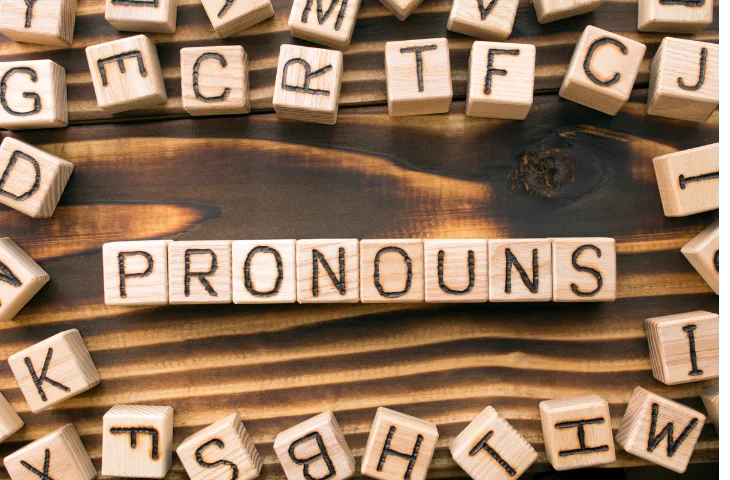Pronouns are an essential part of English grammar and a common topic in competitive exams like SSC, Banking, and RRB. In this blog, we have provided all the details about pronouns from their definitions and types to question patterns and quick solving tricks.
What Is Pronoun in English?
A pronoun is a word that replaces a noun or noun phrase to avoid repetition and make sentences smoother. For example, instead of repeating “Rita,” we use “she” to refer back to her.
Why pronouns appear in exams:
Pronouns test your understanding of sentence structure, subject-verb agreement, and clarity of reference all crucial for effective communication. They also check your logical reasoning and ability to decode sentences quickly.
Skills required:
- Logical understanding of sentence flow
- Visualization of who or what the pronoun refers to
- Decoding sentence meaning and relationships
Why Is Pronoun Important in Competitive Exams?
Pronouns frequently appear in English sections as they test grammar fundamentals and sentence correction skills.
| Exam | No. of Questions | Difficulty |
| SSC CGL / CHSL | 1–2 | Easy |
| IBPS PO / SBI PO | 1–2 | Moderate |
| RRB NTPC / Group D | 1 | Easy |
| State PSC / Police | 1–2 | Moderate |
Types of Pronouns
The details of the types of pronouns are as follows:
| Term | Explanation |
| Personal Pronouns | Refer to specific persons (I, you, he, she, it, we, they) |
| Reflexive Pronouns | Refer back to the subject (myself, yourself) |
| Demonstrative Pronouns | Point to specific things (this, that, these, those) |
| Interrogative Pronouns | Ask questions (who, whom, which, what) |
| Relative Pronouns | Connect clauses (who, whom, whose, which, that) |
| Indefinite Pronouns | Refer to nonspecific things (some, any, nobody) |
| Reciprocal Pronouns | Show mutual actions (each other, one another) |
Logical patterns:
- Pronouns must agree in number and gender with their antecedents.
- Reflexive pronouns used only when subject and object are the same.
- “Who” is for subjects; “whom” is for objects.
Concepts Related to Pronoun Questions
Concepts used to solve questions on pronouns are as follows:
| Concept | Explanation |
| Personal Pronouns | Replace specific people or things |
| Pronoun-Antecedent Agreement | Pronouns must agree with the noun they replace in number & gender |
| Reflexive Pronouns | Used when subject = object |
| Demonstrative Pronouns | Point to particular items or people |
| Relative Pronouns | Connect clauses, refer back to nouns |
| Interrogative Pronouns | Introduce questions |
What Are the Types of Pronoun Questions in English?
Pronoun questions can test multiple skills. Major types include:
- Pronoun Replacement: Choose the correct pronoun to replace a noun
- Pronoun Agreement: Identify errors in pronoun-antecedent agreement
- Reflexive Pronoun Usage: Correct use of reflexive pronouns
- Relative Pronouns: Fill in the blanks with correct relative pronouns
- Interrogative Pronouns: Questions based on “who,” “whom,” etc.
- Demonstrative Pronouns: Choose between “this,” “that,” “these,” “those”
Pronoun Question Patterns in English
To save time, use these mental models:
- Identify the Antecedent: Find the noun the pronoun replaces first.
- Check Number & Gender: Singular nouns need singular pronouns; plural nouns need plural pronouns.
- Subject/Object Roles: Use “who” for subjects, “whom” for objects.
- Reflexive Clarity: Use reflexive pronouns only if subject and object match.
- Eliminate Confusing Options: Drop options that break agreement rules.
Pronoun Tricks for SSC CGL and Other Exams
Here are some quick tips to tackle pronoun questions:
- Read the entire sentence carefully before choosing the pronoun.
- Identify the noun that the pronoun refers to (antecedent).
- Ensure pronoun number and gender match the antecedent.
- Use reflexive pronouns only if the subject and object are the same.
- When in doubt, replace the pronoun with the noun and check sentence correctness.
- For relative pronouns, remember “who” refers to people and “which” to things.
- In questions, differentiate between “who” (subject) and “whom” (object).
Solved Pronoun Questions from 2024–25 Exams
SSC CGL 2024 Tier 1 – Shift 2 (Memory-Based)
Q: Choose the correct pronoun: Each of the players has completed ____ training.
a) their
b) his
c) her
d) its
Answer: b) his
Explanation: “Each” is singular, so the pronoun must be singular masculine or neutral. “His” is the best fit here as a generic singular pronoun.
IBPS PO Prelims 2024
Q: Fill in the blank with correct pronoun: The teacher, along with her students, _____ going to the museum.
a) are
b) is
c) were
d) have
Answer: b) is
Explanation: The subject is “The teacher” (singular). The phrase “along with her students” does not change the singular subject. So, singular verb “is” is correct.
RRB NTPC 2024
Q: Identify the correct relative pronoun: This is the book ____ I was telling you about.
a) who
b) whom
c) which
d) whose
Answer: c) which
Explanation: The pronoun refers to “book” (thing), so “which” is correct.
Pronoun Concepts for Bank Exams
Bank exams like IBPS and SBI often present pronouns in coded or logic-based formats:
- Symbol-based questions where “@” may represent “he,” “#” for “she,” etc.
- Family relation trees requiring you to replace names with pronouns correctly.
- Logical puzzles combining pronoun usage with sentence correction.
Example:
“If @ is father of # and # is sister of $, then who is the uncle of $?” requires understanding pronouns and relations.
Common Mistakes to Avoid while Solving Pronoun Questions
Common mistakes to avoid when solving questions on pronouns are as follows:
- Using plural pronouns for singular antecedents.
- Confusing “who” (subject) with “whom” (object).
- Using reflexive pronouns incorrectly when subject and object differ.
- Ignoring gender agreement of pronouns.
- Overlooking the antecedent in complex sentences.
FAQs
Personal, reflexive, demonstrative, relative, interrogative, indefinite, and reciprocal pronouns.
‘Who’ is used as a subject; ‘whom’ is used as an object.
Use ‘this’ for something near and ‘that’ for something farther away.
They point to specific things or people in context.
Using plural pronouns for singular antecedents or vice versa.
- IBPS RRB Final Reserve List 2025 Released for PO, Clerk & SO
- IBPS SO 3rd Reserve List 2025 Out, Check Provisional Allotment
- IBPS Clerk 3rd Reserve List 2025 Out, CSA Provisional Allotment
- IBPS PO 3rd Reserve List 2025 Out, Provisional Allotment List
- SBI PO vs. SSC CGL: Which is a better career option?
- SSC CGL Tier 2 Shift Timing 2025, Exam, DEST Schedule

Hi, I’m Aditi. I work as a Content Writer at Oliveboard, where I have been simplifying exam-related content for the past 4 years. I create clear and easy-to-understand guides for JAIIB, CAIIB, and UGC exams. My work includes breaking down notifications, admit cards, and exam updates, as well as preparing study plans and subject-wise strategies.
My goal is to support working professionals in managing their exam preparation alongside a full-time job and to help them achieve career growth.
